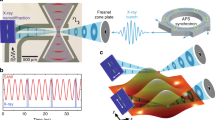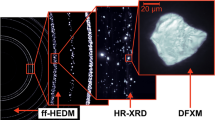Abstract
The understanding and management of strain is of fundamental importance in the design and implementation of materials. The strain properties of nanocrystalline materials are different from those of the bulk because of the strong influence of their surfaces and interfaces, which can be used to augment their function and introduce desirable characteristics. Here we explain how new X-ray diffraction techniques, which take advantage of the latest synchrotron radiation sources, can be used to obtain quantitative three-dimensional images of strain. These methods will lead, in the near future, to new knowledge of how nanomaterials behave within active devices and on unprecedented timescales.
This is a preview of subscription content, access via your institution
Access options
Subscribe to this journal
Receive 12 print issues and online access
$259.00 per year
only $21.58 per issue
Buy this article
- Purchase on Springer Link
- Instant access to full article PDF
Prices may be subject to local taxes which are calculated during checkout




Similar content being viewed by others
References
Pauling, L. The Nature of the Chemical Bond, and the Structure of Molecules and Crystals (Cornell Univ. Press, 1960).
Buffat, P. & Borel, J.-P. Size effect on the melting temperature of gold particles. Phys. Rev. A 13, 2287–2297 (1975).
Madey, T. E., Chen, W., Wang, H., Kaghazchi, P. & Jacob, T. Nanoscale surface chemistry over faceted substrates: structure, reactivity and nanotemplates. Chem. Soc. Rev. 37, 2310–2327 (2008).
Yu, H., Li, J. B., Loomis, R. A., Wang, L. W. & Buhro, W. E. Two- versus three-dimensional quantum confinement in indium phosphide wires and dots. Nature Mater. 2, 517–520 (2003).
Hodge, A. M. et al. Scaling equation for yield strength of nanoporous open-cell foams. Acta Math. 55, 1343–1349 (2007).
Fritz, D. M. et al. Ultrafast bond softening in bismuth: Mapping a solid's interatomic potential with X-rays. Science 315, 633–636 (2007).
Vartanyants, I. A. et al. Coherent X-ray scattering and lensless imaging at the European XFEL facility. J. Synchrotron Radiat. 14, 453–470 (2007).
McCartney, M. R. & Smith, D. J. Electron holography: Phase imaging with nanometer resolution. Annu. Rev. Mater. Res. 37, 729–767 (2007).
Midgley, P. A. & Dunin-Borkowski, R. E. Electron tomography and holography in materials science. Nature Mater. 8, 271–280 (2009).
Kim, M., Zuo, J. M. & Park, G. S. High-resolution strain measurement in shallow trench isolation structures using dynamic electron diffraction. Appl. Phys. Lett. 84, 2181–2183 (2004).
Urban, K. W. Studying atomic structures by aberration-corrected transmission electron microscopy. Science 321, 506–511 (2008).
Varela, M. et al. Materials characterization in the aberration corrected scanning transmission electron microscope. Annu. Rev. Mater. Res. 35, 539–569 (2005).
Hytch, M., Houdellier, F., Hue, F. & Snoeck, E. Nanoscale holographic interferometry for strain measurements in electronic devices. Nature 453, 1086–1089 (2008).
Ade, H. & Stoll, H. Near-edge X-ray absorption fine-structure microscopy of organic and magnetic materials. Nature Mater. 8, 281–290 (2009).
Thibault, P. et al. High-resolution scanning X-ray diffraction microscopy. Science 321, 379–382 (2008).
Rodenburg, J. M. et al. Hard-X-ray lensless imaging of extended objects. Phys. Rev. Lett. 98, 034801 (2007).
Larson, B. C., Yang, W., Ice, G. E., Budai, J. D. & Tischler, J. Z. Three-dimensional X-ray structural microscopy with submicrometre resolution. Nature 415, 887–890 (2002).
Schmidt, S. et al. Watching the growth of bulk grains during recrystallization of deformed metals. Science 305, 229–232 (2004).
Ice, G. E. & Larson, B. C. Three-dimensional X-ray structural microscopy using polychromatic microbeams. Mater. Res. Soc. Bull. 29, 170–176 (2004).
Miao, J. W., Charalambous, P., Kirz, J. & Sayre, D. Extending the methodology of X-ray crystallography to allow imaging of micrometre-sized non-crystalline specimens. Nature 400, 342–344 (1999).
Metzger, T. H., Schulli, T. U. & Schmidbauer, M. X-ray methods for strain and composition analysis in self-organized semiconductor nanostructures. C. R. Phys. 6, 47–59 (2005).
Krause, B. et al. Shape, strain, and ordering of lateral InAs quantum dot molecules. Phys. Rev. B 72, 085339 (2005).
Plantevin, O., Gago, R., Vazquez, L., Biermanns, A. & Metzger, T. H. In situ X-ray scattering study of self-organized nanodot pattern formation on GaSb(001) by ion beam sputtering. Appl. Phys. Lett. 91, 113105 (2007).
Malachias, A. et al. X-ray study of atomic ordering in self-assembled Ge islands grown on Si(001). Phys. Rev. B 72, 165315 (2005).
Richard, M. I. & Metzger, T. H. Defect cores investigated by X-ray scattering close to forbidden reflections in silicon. Phys. Rev. Lett. 99, 225504 (2007).
Malachias, A., Metzger, T. H., Stoffel, M., Schmidt, O. G. & Holy, V. Composition and atomic ordering of Ge/Si(001) wetting layers. Thin Solid Films 515, 5587–5592 (2007).
Brehm, M. et al. Quantitative determination of Ge profiles across SiGe wetting layers on Si (001). Appl. Phys. Lett. 93, 121901 (2008).
Matthews, J. W. & Blakeslee, A. E. J. Cryst. Growth 32, 265–273 (1976).
Fiory, A. T., Bean, J. C., Feldman, L. C. & Robinson, I. K. Commensurate and incommensurate structures in molecular beam epitaxially grown GexSi1-x films on Si(100). J. Appl. Phys. 56, 1227–1229 (1984).
Kegel, I. et al. Determination of strain fields and composition of self-organized quantum dots using X-ray diffraction. Phys. Rev. B 63, 035318 (2001).
Malachias, A. et al. 3D composition of epitaxial nanocrystals by anomalous x-ray diffraction: Observation of a Si-rich core in Ge domes on Si(100). Phys. Rev. Lett. 91, 176101 (2003).
Zhong, Z., Chen, P., Jiang, Z. & Bauer, G. Temperature dependence of ordered GeSi island growth on patterned Si(001) substrates. Appl. Phys. Lett. 93, 043106 (2008).
Gailhanou, M. et al. Strain field in silicon on insulator lines using high resolution X-ray diffraction. Appl. Phys. Lett. 90, 111914 (2007).
Lagally, M. G. & Rugheimer, P. P. Strain engineering in germanium quantum dot growth on silicon and silicon-on-insulator. Jpn. J. Appl. Phys. 41, 4863–4866 (2002).
Prevot, G. & Croset, B. Elastic relaxations and interactions on metallic vicinal surfaces: Testing the dipole model. Phys. Rev. B 74, 235410 (2006).
Eberlein, M. et al. Investigation by high resolution X-ray diffraction of the local strains induced in Si by periodic arrays of oxide filled trenches. Phys. Status Solidi A 204, 2542–2547 (2007).
Minkevich, A. A. et al. Inversion of the diffraction pattern from an inhomogeneously strained crystal using an iterative algorithm. Phys. Rev. B 76, 104106 (2007).
Sutton, M. et al. Observation of speckle by diffraction with coherent X-rays. Nature 352, 608–610 (1991).
Miao, J. & Sayre, D. On possible extensions of X-ray crystallography through diffraction-pattern oversampling. Acta Crystallogr. A 56, 596–605 (2000).
Pfeifer, M. A., Williams, G. J., Vartanyants, I. A., Harder, R. & Robinson, I. K. Three-dimensional mapping of a deformation field inside a nanocrystal. Nature 442, 63–66 (2006).
Landau, L. & Lifshitz, E. Theory of Elasticity (Pergamon, 1986).
Harder, R., Pfeifer, M. A., Williams, G. J., Vartaniants, I. A. & Robinson, I. K. Orientation variation of surface strain. Phys. Rev. B 76, 115425 (2007).
Marks, L. D. Experimental studies of small particle structures. Rep. Prog. Phys. 57, 603–649 (1994).
Kirkpatrick, P. & Baez, A. V. Formation of optical images by X-rays. J. Opt. Soc. Am. 38, 766–774 (1948).
Jefimovs, K. et al. Fabrication of Fresnel zone plates for hard X-rays. Microelectr. Engineer. 84, 1467–1470 (2007).
Snigirev, A., Kohn, V., Snigireva, I. & Lengeler, B. A compound refractive lens for focusing high-energy X-rays. Nature 384, 49–51 (1996).
Born, M. & Wolf, E. Principles of Optics 7th edn (Cambridge Univ. Press, 1999).
Schroer, C. G. et al. Coherent X-ray diffraction imaging with nanofocused illumination. Phys. Rev. Lett. 101, 090801 (2008).
Abbey, B. et al. Keyhole coherent diffractive imaging. Nature Phys. 4, 394–398 (2008).
Williams, G. J. et al. Fresnel coherent diffractive imaging. Phys. Rev. Lett. 97, 025506 (2006).
Quiney, H. M., Peele, A. G., Cai, Z., Paterson, D. & Nugent, K. A. Diffractive imaging of highly focused X-ray fields. Nature Phys. 2, 101–104 (2006).
Huang, W. J. et al. Coordination-dependent surface atomic contraction in nanocrystals revealed by coherent diffraction. Nature Mater. 7, 308–313 (2008).
Zuo, J. M., Vartanyants, I., Gao, M., Zhang, R. & Nagahara, L. A. Atomic resolution imaging of a single double-wall carbon nanotube from diffraction intensities. Science 300, 1419–1421 (2003).
Murray, C. B. Colloidal synthesis of nanocrystals and nanocrystal superlattices. IBM J. Res. Dev. 45, 47–56 (2001).
Marchesini, S. et al. X-ray image reconstruction from a diffraction pattern alone. Phys. Rev. B 68, 140101 (2003).
Sayre, D. Some implications of a theorem due to Shannon. Acta Crystallogr. 5, 843–843 (1952).
Shannon, C. Communication in the presence of noise. Proc. Inst. Radio Engineers 37, 10–21 (1949).
Bates, R. H. T. Fourier phase problems are uniquely solvable in more than one dimension. 1. Underlying theory. Optik 61, 247–262 (1982).
Fienup, J. R. Phase retrieval algorithms: a comparison. Appl. Opt. 21, 2758–2769 (1982).
Williams, G. J., Pfeifer, M. A., Vartanyants, I. A. & Robinson, I. K. Effectiveness of iterative algorithms in recovering phase in the presence of noise. Acta Crystallogr. A 63, 36–42 (2007).
Vartanyants, I. A., Pitney, J. A., Libbert, J. L. & Robinson, I. K. Reconstruction of surface morphology from coherent X-ray reflectivity. Phys. Rev. B 55, 13193–13202 (1997).
Vartanyants, I. A. & Robinson, I. K. Partial coherence effects on the imaging of small crystals using coherent X-ray diffraction. J. Phys. Condens. Matter 13, 10593–10611 (2001).
Acknowledgements
We acknowledge the collaboration of M. Watari, M. Newton, S. J. Leake, R. A. McKendry and G. Aeppli in the experimental work presented in Fig. 4. That previously unpublished research was supported by a Royal Society Wolfson Award, a European Seventh Framework Programme Advanced Grant and the Engineering and Physical Sciences Research Council grant EP/D052939/1. The CXD instrumentation, based at APS beamline 34-ID-C, was built with US National Science Foundation grant DMR-9724294 and supported by the Materials Research Laboratory of the University of Illinois under US Department of Energy (DOE) contract DEFG02-91ER45439. The APS is operated by the US DOE contract number W 31 109 ENG 38.
Author information
Authors and Affiliations
Corresponding author
Rights and permissions
About this article
Cite this article
Robinson, I., Harder, R. Coherent X-ray diffraction imaging of strain at the nanoscale. Nature Mater 8, 291–298 (2009). https://doi.org/10.1038/nmat2400
Issue Date:
DOI: https://doi.org/10.1038/nmat2400
This article is cited by
-
Three-dimensional domain identification in a single hexagonal manganite nanocrystal
Nature Communications (2024)
-
Imaging the strain evolution of a platinum nanoparticle under electrochemical control
Nature Materials (2023)
-
Strain and crystallographic identification of the helically concaved gap surfaces of chiral nanoparticles
Nature Communications (2023)
-
Ptychographic X-ray computed tomography of porous membranes with nanoscale resolution
Communications Materials (2023)
-
X-ray-to-visible light-field detection through pixelated colour conversion
Nature (2023)



